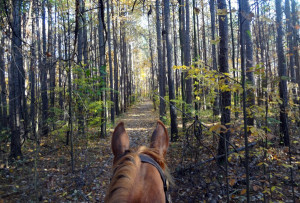The thrill of the show ring is why one has a show horse, right? But trail riding can provide thrills and challenges as well, or just some quiet time with your equine partner, or sometimes a little bit of both!
If your horse is not accustomed to being worked outside an indoor arena at all, the first step would be to work it in a safe outdoor place on the farm, either an outdoor arena, a paddock that is fairly flat and free of obstacles, or possibly up and down the driveway. This will get you ahead for when you arrive to show at facility where the indoor warm-up area is either tiny or none existent; warming up outside won’t be a big deal. (Editor’s Note: We always recommend wearing a helmet, especially during new training situations or potentially unsafe conditions like trail riding.)
 If your horse has not been worked outside at all, you may want to start with ground work, either working your horse on a lunge line with side reins for some measure of control or in long lines. Work the horse until it is responsive and listening to you. If it takes some time, repeat the ground work lessons outside until your horse isn’t flying like a kite on a string every time you go outside. Show horse ways are great, but a responsive, controllable horse is a safety factor when you are not confined in an indoor arena.
If your horse has not been worked outside at all, you may want to start with ground work, either working your horse on a lunge line with side reins for some measure of control or in long lines. Work the horse until it is responsive and listening to you. If it takes some time, repeat the ground work lessons outside until your horse isn’t flying like a kite on a string every time you go outside. Show horse ways are great, but a responsive, controllable horse is a safety factor when you are not confined in an indoor arena.
Once your horse is working well outside from the ground, start working it outside under saddle. You should feel a horse that is willing to go forward, that is confident in you. Ride over varying terrain around the stable yard, ride over ground poles, and always ride with a light hand that gives the horse the confidence that the best way to go is forwards. A nervous rider who becomes heavy handed or jerky with the bridle will not do much to instill in a horse a desire to proceed forward.
When it comes time to hit the trails for the first time, recruit a riding partner with an experienced trail horse. If the stable you board at has access to trails from the property that is wonderful; however, many people have to trailer to a park or trailhead to access trails. If you have to trailer to the trails, acquaint your horse with other things he may not be accustomed to such as straight tying to the side of the trailer or a hitching post (many show horses spend their entire lives only ever being cross tied). Make sure he has good bridling manners so that you don’t have a loose horse incident when bridling or unbridling. Common safety procedure that many horsemen follow that is not habit for most show horse people is to unbuckle the halter (with lead rope attached), slip it off the horse’s nose and re-buckle it just around the horse’s neck so you still have a handle on your horse while bridling. Many western riders simply leave the halter on under the bridle, and if your horse does not need a caveson this works just fine. Teach him to stand quietly for mounting without being held by another person. Also, if your horse has trailering issues, work on resolving them before you go to a public park or trailhead.
So you’ve got your trail buddy on their seasoned trail horse and you’re ready to go. Don’t make the first ride an arduous one. Choose easy terrain with groomed trails, and limit obstacles such as water or bridge crossings if possible. Don’t choose a trail near railroad tracks or a busy highway, or shared use or dual surface trails where you will have bicyclists, as each of those things is upping the difficulty factor. One of the county parks near me has trails that are for horseback riders and hikers only, and the hikers are not allowed to have dogs. What a great place to bring an inexperienced trail horse! Weekdays during the day can be the best time to go, as some places are very crowded on the weekends and some people’s idea of trail riding is galloping from place to place with a six pack in their saddle bags! If you don’t know the trails well in your area, hopefully your trail buddy has some recommendations. If you don’t know anyone who trail rides, perhaps you can meet someone through Facebook or a message board, but meet them at a public place beforehand (internet safety and all that). Plan a route that will have you out for an hour or two your first time out.
 Let your trail buddy’s horse lead at first, but as your horse gets comfortable, take turns leading, following, or just riding abreast. Spend most of your time walking, working in some trotting and even cantering if things are going well and there is a straight, level stretch of trail. Let your horse go forward and be confident. If you feel him questioning a situation, ask your trail buddy to take the lead and let your horse’s natural herd instinct help him go past any scary things. If something is proving very scary, engage his show horse training: pick him up in the bridle a bit and TROT him forward, walking afterwards and praising him for being brave. Ultimately you want a horse that is responsive and paying attention to you while also relaxing and enjoying himself. A horse that has to be ridden on a taut rein and given direction every step of the way just as when you are riding him in the arena is going to tire both of you out. Eventually you would like your horse to be enjoyable for a half or a full day’s ride!
Let your trail buddy’s horse lead at first, but as your horse gets comfortable, take turns leading, following, or just riding abreast. Spend most of your time walking, working in some trotting and even cantering if things are going well and there is a straight, level stretch of trail. Let your horse go forward and be confident. If you feel him questioning a situation, ask your trail buddy to take the lead and let your horse’s natural herd instinct help him go past any scary things. If something is proving very scary, engage his show horse training: pick him up in the bridle a bit and TROT him forward, walking afterwards and praising him for being brave. Ultimately you want a horse that is responsive and paying attention to you while also relaxing and enjoying himself. A horse that has to be ridden on a taut rein and given direction every step of the way just as when you are riding him in the arena is going to tire both of you out. Eventually you would like your horse to be enjoyable for a half or a full day’s ride!
If you are fortunate to have a horse that is shod fairly plainly for showing and you have access to well-groomed trails over level or gently rolling terrain, you may be able to trail ride in your horse’s show shoes. However, if your horse wears a large or heavy package and/or you only have access to more extreme terrain, you may have to change your horse’s shoeing for trail riding. Some trail riding can be done with a barefoot horse; however, depending on the horse, you may need to shoe it if you are doing a lot of riding on gravel roads or on trails where shoes are recommended (you can usually find that information online in the trail description).
In the long run, trail riding will do a lot for your show horse’s well-being, mentally and physically, by learning the difference between when he is being bridled up and having his show horse buttons pushed versus when you are just going for a ride and he can enjoy the scenery. The varied terrain and hill work will provide physical cross training. Whether you trail ride year round or just in the off season, getting your horse to be a sensible, confident mount outside the confines of an arena will pay off in the long term.
- Trail Riding Your Show Horse - June 7, 2015
- Getting the Most Out of Lessons - May 27, 2015
